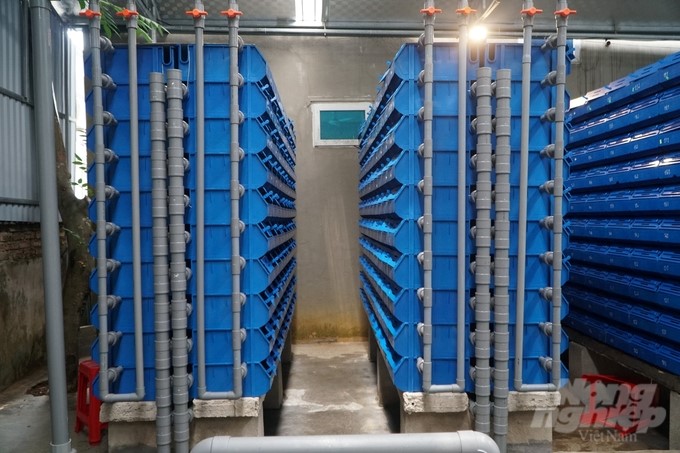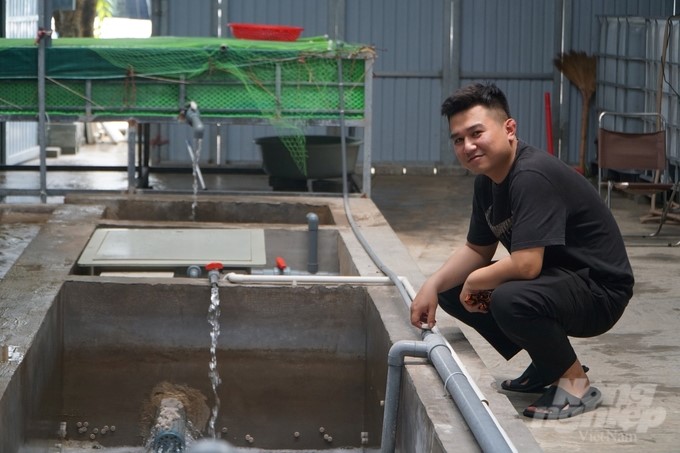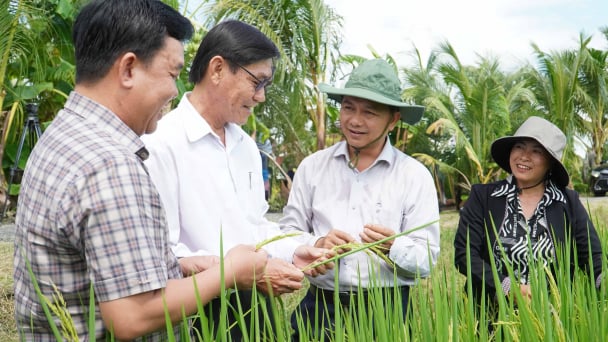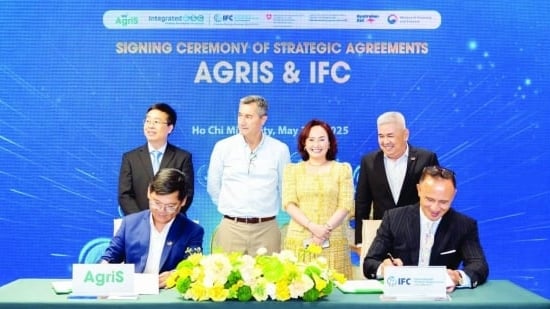June 18, 2025 | 23:50 GMT +7
June 18, 2025 | 23:50 GMT +7
Hotline: 0913.378.918
June 18, 2025 | 23:50 GMT +7
Hotline: 0913.378.918
In 2021, Mr. Luong Anh Thien accidentally read a manual on raising sea crabs in a plastic box, so he came up with the idea of realizing it by model. After accumulating practical experience, he decided to invest in a "cage" to raise crabs on an area of approximately 200 m2 in Thuong Xuan town (Thanh Hoa).
Initially, he experimentally raised 200 sea crabs and achieved positive results. Realizing that sea crab is a popular seafood with high nutritional value, in 2022, Mr. Thien decided to invest an additional hundreds of millions of dongs to buy machinery and equipment for crab farming with a scale of 1,000 boxes.

Raising crabs in plastic boxes brings a high income to Mr. Thien. Photo: QT.
According to Mr. Thien, crabs are easy to live with little care and bring a high income, but they require large initial investment costs and efforts. "The most difficult thing in sea crab farming is the stage of getting water from the sea to treat the salinity to suit the crab's habitat. Thuong Xuan is hundreds of kilometers away from Sam Son Beach (Thanh Hoa), so I have to rent a car to transport water from the sea to the mountain. Sea water after being brought back will be treated with suitable salinity to put into the farming box," he said.
To maintain the amount of sea water needed for crab farming, he installed a system of water filter tanks according to the principles of gas recirculation and oxygen generation. Dirty residue is treated by the filter tank system, then reused and put into plastic boxes to raise crabs. The system helps save sea water and ensure cleanliness and safety for crabs to grow and develop.

Mr. Thien is the first person in Thanh Hoa to successfully raise sea crabs in plastic boxes. Photo: QT.
According to Mr. Thien, besides the filter system, to ensure the living environment for crabs, farmers must carry out microbiological culture to treat leftovers and kill bacteria and waste, making the crab's habitat cleaner. In addition, the major advantage of the indoor crab farming system is that it takes less space, gives a high yield and quality, and is easy to control diseases and quality.
"Each plastic box is usually used to raise one crab. If raising two crabs in the same plastic box, their claws must be tied to avoid the crabs "fighting". Crab farming boxes are stacked with multiple layers, numbered, and recorded every day on the effectiveness of care on the box case. Every day, the plastic box must be checked at least once in order to promptly detect the disease and have a timely handling solution," Mr. Thien shared.

The "mini apartment," consisting of stacked plastic boxes, is the living place of crabs. Photo: QT.
According to Mr. Thien's experience, there are a few differences between raising sea crabs in a box and raising crabs in the lagoon. Raising crabs in plastic boxes requires dropping food into each box to feed the crabs and precise control of the quantity of farmed crabs. However, crabs raised in plastic boxes are less prone to diseases, convenient to care for, and quickly and easily harvested. Food for crabs is mainly golden apple snails. Crabs reared for about 20 days can be sold with a weight of about 300g/head.
Every month, Mr. Thien sells more than 300kg of male crab to the market at a price of VND 350,000–450,000/kg and 30kg of soft-shell crab at a price of over VND 800,000/kg. After minusing all expenses, he earns VND 30–50 million. Mr. Thien's crab farming model creates regular jobs for two workers with an income of VND 6-7 million/person/month.
Mr. Thien added that because of the market’s large demand for sea crabs, his family's crab "cage" is not enough to supply customers, especially in the summer when the number of tourists flocking to Sam Son and sea tourism areas increases highly.

Mr. Thien invested hundreds of millions of dongs in the system of seawater filter tanks and bunker tanks. Photo: QT.
After two years of implementation, Mr. Thien's model of raising crabs in a "mini-apartment" has brought initial success with high economic efficiency. The model is attracting the interest of many farmers to visit and learn from experience. The quality of crab meat at Mr. Thien's model is highly appreciated by customers.
"Customers can be assured of the meat quality of the crabs raised in the box because the care process is very scientific and thorough. The finished crab always ensures freshness and cleanliness, from the process of raising to the time to eat," shared Mr. Luong Anh Thien.
Translated by Huyen Vu Thu
/2025/06/17/3942-2-143243_548.jpg)
(VAN) Recently, in Sweden, the Secretary of the Binh Dinh Provincial Party Committee presented the Investment Registration Certificate for the 'Polyester Fabric Recycling Complex' project to SYRE Impact-AB Company.
/2025/06/12/3721-2-202745_83.jpg)
(VAN) TH made an impression at Seoul Food 2025 with its line of natural beverages, paving the way for Vietnamese food products to enter the South Korean market.

(VAN) Soc Trang's success in rice exports stems from a strategy of developing fragrant and specialty rice cultivation areas and standardizing production toward low-emission practices.
/2025/06/11/1311-5-120811_839.jpg)
(VAN) The pig farming industry is facing the challenge of comprehensive restructuring to meet requirements for quality, safety, traceability, and market expansion both domestically and for export.

(VAN) Vietnam considers participating in ALGROALBA in order to expand agricultural production, coordinate the assessment and effective exploitation potential land.
/2025/06/05/5314-1-184727_407.jpg)
(VAN) From seemingly worthless fish scales and skin, enzymes and lactic ferments can transform by-products into peptides, opening a sustainable, effective business direction and elevating Vietnamese seafood.

(VAN) TTC AgriS and IFC signed a strategic partnership to develop a sustainable agricultural value chain, aiming to achieve the Net Zero target by 2035.